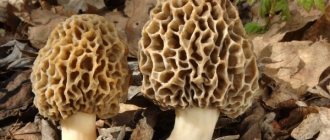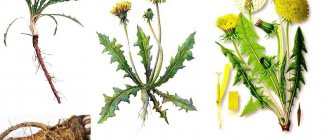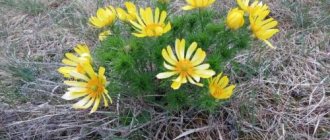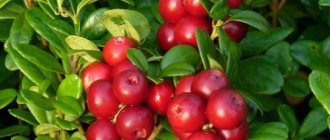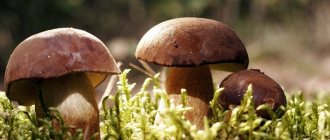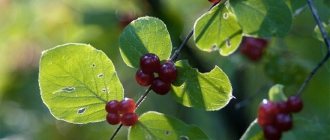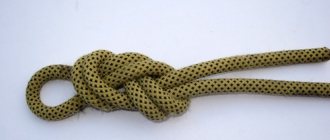Edible pig mushrooms - types, what they look like, what they can be confused with: description, photo
Pig mushrooms
The fact is that almost all the recipes involving pigs that are now available on the Internet arose during the war, when there was a shortage of food. Accordingly, people ate everything they could get their hands on.
Description:
- Many people believe that pig mushrooms are truly edible. And despite the bitter taste, they can be eaten. The only thing is that before consuming, you need to boil them for about half an hour in water in order to remove the bitterness.
- But some studies have found that pig mushrooms are very dangerous and should not be eaten because they contain protein that can accumulate in the body and destroy red blood cells. And this promotes rapid blood clotting.
- But among the pigs there are also edible varieties, if they belong to the Tapinella genus.
- They look like quite dense, large mushrooms. The leg is underdeveloped. It is thick, short, and has a large funnel-shaped cap. In this case, along the edge the cap can be curved downwards. The color is brown or brownish and is present on the inside of the cap of the plate. This is a fat pig (lat. Tapinella atrotomentosa) - and according to mushroom pickers it is edible.
- In rainy weather, the pulp becomes heavily saturated with moisture and when cut, water oozes out of it.
Until 1981, pig mushrooms were considered conditionally edible mushrooms. Since 1993, all pig mushrooms have been officially considered inedible and poisonous mushrooms.
Also, pigs have a good ability to absorb toxic substances near industrial zones, roads and railways.
Fat pig
Svinushka mushrooms - false: varieties, what they look like, description, photo
Varieties:
- Among the pigs there are also inedible varieties. This is a thin pig, as well as a house mushroom , which now grows in cellars. These types of mushrooms should not be eaten, they are poisonous.
- Thin, poisonous pigs are also called dunki, cow's lip, and pig's lip.
Thin pig
House mushroom
Dunki (pigs, cow's lips)
Alder pigs also belong to the inedible mushrooms. The pulp is dense, white-gray in color. The pulp is yellowish or brown, spongy. On the reverse side the plates are less developed. The leg is also short. Found mainly in September, it is characterized by a slightly bitter taste.
Alder pig
Description of the thin pig
The thin pig belongs to the Svinushkov family and is widespread throughout Europe and central Russia. It grows in both coniferous and deciduous forests; most often it can be found in birch groves, thickets of bushes, on the outskirts of ravines and swamps. It is also found in oak groves, on forest edges, under pine and spruce trees, and in the roots of fallen trees.
The mushroom prefers well-moistened soils, and usually grows in large groups—single thin pigs are less common. Peak fruiting occurs in late summer and early autumn. At the same time, the first pigs can be found already in June, and they continue to grow until October.
Important! The mushroom got its name precisely because it can often be seen in unremarkable places that at first glance are unsuitable for growth - near snags and rotten stumps, next to dead wood and ant heaps. Sometimes pigs are even found on the foundations and roofs of abandoned buildings.
How to distinguish a thin pig from a fat one: comparison, similarities and differences
Thin and thick pigs differ from each other, but the fact is that thick pigs are edible only in the opinion of mushroom pickers.
They differ in the diameter of the cap. In a thick pig, it is up to 20 cm in diameter, while the leg is short, thick, fleshy and 4-5 cm in diameter. But in a thin pig, the leg is thinner and the cap is smaller.
Please note that many mushroom pickers consider thin pig mushroom to be an edible mushroom; if you boil it for half an hour, there is no danger. Then they need to be fried or salted. But not so long ago, studies were carried out according to which the thin mushroom or Dunka, as it is also called, is an inedible mushroom. The fact is that the toxins of this fungus are not excreted, accumulate in the blood, and destroy red blood cells. That is, hemoglobin is gradually removed from them, the kidneys and also the liver are affected.
Anemia, jaundice, and anemia may occur. And the most interesting thing is that during boiling, such mushrooms will not get rid of toxins. According to information provided on Wikipedia, since the end of the 20th century, thick and thin pig mushrooms have been classified as poisonous mushrooms.
Thin Pig Thick Pig
Types of pigs, photos and names
The genus Svinushka is quite well studied, it includes 35 species of mushrooms. Below are the common varieties of pigs:
- Slender pigtail ( Paxillus involutus )
It grows in the countries of Eastern, Central and Southern Europe, as well as in Russia. This mushroom can be found near ravines, along the edges of swamps, in the roots of fallen trees, as well as in young forests with oaks and birches.
The olive-brown cap of a young mushroom becomes rusty-brown as it ages, with a noticeable gray tint. Its diameter ranges from 12 to 20 cm. The dense flesh of the pig is colored pale yellow, over time it becomes loose and yellowish-brown. The leg is cylindrical and rather short, rarely reaching a height of 6 cm. A decrease in its diameter from the cap to the ground is often noted. Its smooth surface is painted almost the same as the cap, but in lighter colors. Wide and sparse plates on the lower surface of the cap quite often have a cellular structure due to the numerous bridges connecting them. Pigweed spores are thin ellipsoidal in shape, with a smooth surface.
The thin pig bears fruit from the beginning of June to the first ten days of October.
- Alder pigweed (Paxillus filamentosus)
A poisonous mushroom that grows in deciduous and mixed forests of the European territory of Russia, Germany, France, Poland, Romania, Italy, Spain, Belarus and other European countries. Forms a symbiosis with alder and aspen.
The cap with a slight funnel-shaped shape and a slightly lowered wavy edge can reach a diameter of 8 cm. The color of the pig's cap is yellowish-brown or reddish-brown with an ocher tint. The surface of the cap is dry, covered with pronounced scaly cracks. The yellowish pulp has a dense consistency without a pronounced odor; as it ages, it becomes loose. Often located ocher-yellowish plates are scattered along the stem, often forming cellular weaves at the base. The leg of the alder pigwort is low, rarely exceeds 5 cm in length with a maximum diameter of about 1.5 cm. It has a pronounced narrowing in the direction from the cap to the surface of the ground.
Alder mushrooms bear fruit from late June to mid-September.
- Thick pig (felt) (Tapin e lla atrotoment o sa)
A rather rare species of pigs, found in European countries with temperate climates. It grows mainly in coniferous forests on uprooted roots, old stumps or fallen pine needles.
The hat is quite large in size, with the edges tucked inward, and can reach 20 cm in diameter. As the fungus grows, its shape can take on a disproportionate shape, resembling an elongated tongue. The surface of the cap, painted brown or olive-brown, is slightly velvety, dries out and cracks with age. The pulp of a thick pig has a watery consistency, without a distinct odor, and is yellowish in color. The plates are light yellow in color; when pressed, they change color to dark brown. The short olive-brown or brown leg with a fleecy coating has a dense, fleshy consistency and is quite often shifted to the edge of the cap.
- Tapinella panuoides ( Tapinella panuoides)
The fruiting body of the mushroom consists of a hard cap, reaching a size of 12 cm, and a small stalk, which is sometimes practically absent, growing and merging with the cap. The cap of the mushroom is fan-shaped; less common is the ear-shaped mushroom with a shell-shaped cap. The edge of the cap is uneven, with frequent teeth or waves. The surface is slightly velvety in young specimens, but in old mushrooms it becomes absolutely smooth. The color of the cap ranges from yellowish-brown to ocher. The ear-shaped pig has a rather dense, slightly rubbery flesh of a yellowish-cream or light brown color; when pressed, the flesh does not change color, and has a pronounced resinous-pine aroma.
Earwort is widespread in the coniferous forests of Russia and Kazakhstan; it grows in groups or singly, preferring to settle on fallen pine needles or on dead wood of coniferous trees. The pig often chooses the walls of wooden buildings as its habitat, which causes them to rot.
The ear-shaped pig is a mildly poisonous mushroom that is not eaten due to the presence of toxins in its fruiting body that provoke hematopoietic disorders.
- Pigweed Paxillus ammoniavirescens
Poisonous mushrooms that grow in Italy, Portugal, Germany, France, Spain, England, Sweden and some North African countries. This mushroom is common in city parks and gardens at the foot of deciduous and coniferous trees, although it is found in forests on the edges and along the banks of small rivers.
The mushroom is short (up to 10 cm in height) with a fleshy, dense cap, painted in beige-brown tones with a barely noticeable olive tint and a diameter of no more than 12 cm. It appears en masse in the fall. Pigweed spores are quite large, reaching 6 microns in size, and brown in color.
- Pigweed Paxillus obscurisporus
From early spring to late autumn they are found in coniferous forests, on the edges of oak and linden groves, as well as open pastures. The hat, colored light brown or golden brown, has a slightly wavy, raised edge. Its diameter ranges from 4 to 13 cm. The white flesh with a brown tint has a pleasant, mild odor. The height of the leg, slightly expanding from the surface of the ground to the cap, does not exceed 8 cm, and its color varies from gray to yellowish. The plates on the underside of the cap are golden brown or reddish in color.
Pigweed mushrooms Paxillus obscurisporus bear fruit from early summer to autumn.
- Pigweed Paxillus rubicundulus
It has a characteristic funnel-shaped cap up to 15 cm in diameter, with a smooth or velvety surface. The color of the pig's cap can be brown, yellowish-brown, gray-brown, rusty-ocher with a reddish tint. The color of the pork flesh varies from white to yellow-brown, changing to red-brown when cut. The leg is up to 8 cm high, cylindrical in shape, yellowish in color, and becomes reddish-brown with age. The plates are frequent, thin, yellowish-red or yellow-brown in color, becoming dark brown at the point of contact.
This variety of pigs is widespread in all European countries. It prefers moist lands along river banks, as well as light forests, in which it forms a symbiosis with alder.
- Pig mushroom Paxillus vernalis
They grow in the mountain forests of North America, in which they form symbiotic relationships with aspen and birch. They are also found in Estonia, Denmark and Great Britain. The mushroom bears fruit from late summer to mid-autumn.
The cap is fleshy, convex, with a smooth or slightly rough surface, painted in various shades of yellow-brown. The yellowish, dense flesh of the pork has no distinct odor; when cut, it acquires a reddish-brown color. The height of the leg can reach 9 cm, and the maximum diameter is 2-2.5 cm. The color of the leg matches the color of the cap. The plates are yellowish or pale olive, often fused together.
Edible and inedible pig mushrooms: names, photos
There are few mushrooms similar to pig mushrooms. Svinushka is quite noticeable and easily distinguished from other mushrooms.
According to Wikipedia, the fat mushroom is a conditionally edible mushroom. It is believed that pre-boiling for 30 minutes can remove toxins. Next, you can prepare a variety of dishes from it. In foreign sources, this mushroom is classified as inedible mushrooms due to its low nutritional qualities. The toxic properties of this mushroom have not been fully studied. These mushrooms are considered to have slow-acting poison.
Photos and names of pigs:
Fat pig
Alder pigweed is a mildly poisonous mushroom
Pig talker
Pig eared
Is it necessary to clean the pigs from the skin and film?
If, despite the fact that mushrooms are conditionally edible (more often called slow-acting poison), you still decide to collect, cook, or pickle them for the winter, we recommend that you soak them in cold water for an hour before processing . During this time, all debris, straws, grass, and soil will come off. It is imperative to remove the sticky film from the surface. Please note that during cleaning, your hands get very dirty and do not wash for a long time. We recommend wearing gloves before cleaning.
pigs
How to process pig mushrooms?
Pig mushrooms are more resistant to worms than other mushrooms (possibly due to toxicity). Therefore, cleaning them is easy. Under no circumstances should you delay cleaning and preparing mushrooms. This is a product that needs to be cleaned immediately, a few hours after collection.
Instructions:
- To do this, you need to cut off the dirt and soak the mushrooms in cold water for 30 minutes.
- Next, use a knife to scrape off the film and remove the stickiness.
- It is necessary to soak the mushrooms again for 2 hours in cold water.
- After this, you need to boil the pork for 30 minutes.
- Under no circumstances should you use the decoction you receive for food.
- Because it contains toxic substances that can cause poisoning
- Pour out this broth, throw the mushrooms in a colander and wait until all the liquid has drained
- Soak the already boiled pigs in cold water for another 30 minutes.
- Only after this can you begin salting or further heat treatment.
Harvest of sinews
Are pig mushrooms healthy: benefits and harms
Since the end of the 20th century, Tolsta I, which is mainly common in our area, has been classified as a conditionally poisonous mushroom. After preliminary preparation, a significant part of not only harmful, but also beneficial substances is washed out and goes into the water in which the product is soaked.
Benefit:
- It is worth noting that pigs contain a large amount of lecithin. This is a special protein that does not allow harmful cholesterol to accumulate in the body and prevents stroke and heart attack.
- It contains a lot of fiber, which stimulates intestinal function.
But still, these mushrooms are quite controversial . Many modern scientists believe that they should not be eaten at all, because they contain a toxic substance that can accumulate in the body and, over time, cause serious disruption in its functioning (read about the effects on the body in the article above).
Harm:
- Over time, disruptions in the functioning of the liver and kidneys, as well as the circulatory system, may occur. Please note that the older the mushroom, the more harmful it is. It is in old mushrooms that harmful substances accumulate.
- Due to the presence of muscarine, pig mushroom was classified as a conditionally poisonous mushroom. This poison is also found in fly agarics. The fact is that during boiling, it does not split and does not go into water. Some of it still remains in the mushrooms, so there is a risk of poisoning.
List of poisonous mushrooms
Svinushka - a mushroom that cannot be eaten twice
Mushroom pickers are well acquainted with the pig mushroom, or thin pig mushroom (Paxillus involutus). In various places in Russia it is called pig, pig's ear, solokha, straw, dunka, filly, cowshed or cow's lip.
Photo: candy18/ ru.depositphotos.com.
The pig is thin. Photo by Ivan Zmitrovich.
Red pig. Photo by Ivan Zmitrovich.
The sow is dark-spored. Photo by Alexander Ivanov.
‹
›
Thin mushroom is a cap mushroom from the family Paxillaceae of the order Boletales of the class Agaricomycetes. It grows in mycorrhizal symbiosis with deciduous and coniferous trees, but prefers birch forests in central Russia. appears in August - September. The mushroom cap is initially flat, but as it grows it becomes depressed and funnel-shaped. The color of the cap is clay-olive; in older mushrooms it is brownish. The edges are rolled inward. Dirty yellowish plates, devoid of covers, run down to the stem, where they are often connected to each other by bridges. The plates are easily separated from the cap and become dark brown when pressed. The leg is usually short, thick, solid, smooth, the same color as the cap or lighter. The flesh of the mushroom is fleshy, dirty yellowish, and turns brown at the break. Like all boletus mushrooms, the thin mushroom has a brownish spore powder and colored thick-walled spores.
Thanks to genetic studies, it was possible to find out that under the name of the thin pig, there are several species, of which, in addition to the thin pig (P. involutus sensu stricto), in European forests there are green pig (P. ammoniavirescens), black pig (P. obscurisporus), and red pig (P. rubicundulus) and copper pig (P. cuprinus).
Until the 1980s, in Russian mycological and popular literature, the thin pig was considered an edible mushroom, although with some reservations. Thus, in Boris Pavlovich Vasilkov’s album “Mushrooms,” widely known in the USSR, the species is characterized as follows: “Edible mushroom, category IV; occasionally used fresh (boiled and fried) and salted; must be boiled before salting, otherwise poisoning is possible.” During these same years in Europe, popular mushroom guides listed the thin mushroom as a deadly mushroom. In 1981, a ten-year study of cases of poisoning by the thin pig was completed in Poland. In 93 of the 109 cases of poisoning, patients were hospitalized, and three people died.
In the USSR, thin pigweed was excluded from the list of mushrooms allowed for harvesting in 1981, but some mushroom pickers continued to collect it, considering it tasty and safe. In the early 1980s, the Botanical Institute named after. V.L. Komarov was brought a jar of pickled mushrooms for mycological examination. The mushrooms were collected near the city of Priozersk, Leningrad Region. The young woman who ate them died within 24 hours. Examination of the contents of the jar revealed fruiting bodies and spores of the tonka pig. After this incident, every mushroom season, mycologists at the Botanical Institute warned the population about the danger of pig poisoning. In 1984, the thin mushroom was finally included in the list of poisonous and inedible mushrooms.
Since the mid-1980s, the term Paxillus syndrome - pig syndrome - has appeared in the specialized literature. Its typical symptoms are: nausea, stomach colic, vomiting, pain in the upper abdomen, back and arms, shortness of breath, circulatory problems, extreme weakness.
It’s a paradox, but when you first consume pig, no acute symptoms of poisoning are usually observed. Mortal danger arises when these fungi re-enter the body. The fact is that Paxillus syndrome is an autoimmune reaction that occurs due to some as yet unidentified antigen contained in the thin pig. At the first contact with the pig antigen, B lymphocytes begin to produce antibodies to it. Antibodies form immune complexes with the antigen, and although these complexes are quite effectively destroyed by immune cells, they often persist for a long time and are deposited in various tissues and organs. When the antigen re-enters the blood, a type III hypersensitivity reaction may occur, when cytotoxic immune reactions are activated in the area of deposits of immune complexes, which destroy red blood cells and disrupt blood clotting. This leads to hemolysis and thromboembolism and, as a consequence, to renal failure, liver damage, and respiratory failure due to the destruction of red blood cells.
Because there is no reaction when mushrooms are first consumed, pig syndrome has eluded epidemiological studies. As you can see, the thin pig is an insidious mushroom.
For mushroom pickers living in the forest-steppe and steppe zones, warnings regarding the dangers of eating pigs for food sometimes cause bewilderment. Mushrooms growing in birch forest belts (in particular, dark-spore mushroom) are widely harvested and traditionally used as food. It can be assumed that different species and geographical races of pigs contain the antigen that causes an autoimmune reaction in different concentrations. This, however, does not reduce the risk of poisoning, since only a specialist can distinguish between different species of this genus.
In recent years, pharmacologists and oncologists have become interested in a number of substances produced by the guinea pig - the oxidatively active pigment involutin and heteroglycans. They were toxic to various cancer cell lines. So, thin pig, which is dangerous as a food product, may in the future turn out to be a valuable raw material for the production of bioactive components.
Can there be poisoning from pig mushrooms?
The mushroom is classified as conditionally poisonous and is not recommended for consumption. There are cases of fatal poisoning from pig mushrooms . This mainly happens if you eat not young, but old mushrooms with huge caps. Many scientists note that muscarine, which is contained in fly agarics and pig mushrooms, even if the mushrooms are boiled for 3 hours, remains in the product and can cause serious poisoning. And after three hours of processing, the mushrooms turn into mucus and become inedible.
Therefore, before eating and preparing these mushrooms, think a hundred times . Scientists have proven that pig mushrooms also accumulate heavy metals, which can subsequently cause serious toxic poisoning and disruption of the functioning of many internal organs.
Insidious mushrooms
Your health is in your hands. Don't take risks, because you can find a huge number of edible mushrooms on the shelves. Instead of pig mushrooms, you can collect healthier mushrooms, such as chanterelles and boletus mushrooms.
Symptoms of pig poisoning
Symptoms of mushroom poisoning do not always appear and not necessarily immediately after eating mushrooms. People's sensitivity to mushroom toxins varies; the most sensitive category is children.
Signs of pig poisoning include the following:
- vomit,
- abdominal pain,
- diarrhea,
- yellowness of the skin,
- a sharp decrease in the volume of daily urine output,
- increased level of hemoglobin in urine,
- oligoanuria (in severe cases).
